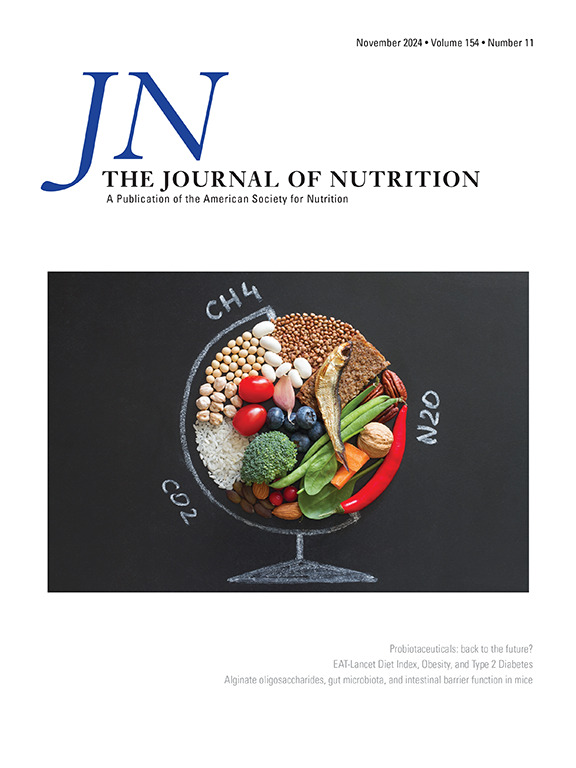日本男性和女性膳食纤维摄入量与2型糖尿病:基于日本公共卫生中心的前瞻性研究
IF 3.8
3区 医学
Q2 NUTRITION & DIETETICS
引用次数: 0
摘要
背景:据报道,总膳食纤维和谷物纤维摄入量与2型糖尿病风险降低有关。然而,来自亚洲的证据有限且不一致。此外,日本也没有研究过从食物中摄取膳食纤维的关系。目的:我们前瞻性地研究了日本成年人膳食纤维及其来源与2型糖尿病风险的关系。方法:参与者是27,798名男性和36,883名女性,年龄在44-76岁之间,他们在1995-1998年(本研究的基线)完成了一份食物频率问卷,没有糖尿病史,并在五年后返回随访问卷,当医生诊断为2型糖尿病时自我报告。根据膳食纤维摄入量估算新诊断的2型糖尿病的优势比。结果:5年期间共确诊新诊断2型糖尿病1190例。总膳食纤维摄入量与2型糖尿病无显著相关性;总膳食纤维摄入量最高和最低四分位数的2型糖尿病的多变量校正优势比为0.91(95%可信区间0.72-1.15)(趋势P = 0.36)。通过食物来源分析,谷物、豆类、蔬菜和水果的膳食纤维摄入量与2型糖尿病无关,对应值(95%置信区间)为:谷物0.95(0.79-1.14),豆类0.96(0.78-1.19),蔬菜1.00(0.81-1.23),水果1.12(0.90-1.39)。结论:我们的研究结果表明,膳食纤维摄入量与日本人患2型糖尿病的风险无关。本文章由计算机程序翻译,如有差异,请以英文原文为准。
Dietary Fiber Intake and Type 2 Diabetes in Japanese Men and Women: The Japan Public Health Center-Based Prospective Study
Background
Total dietary fiber and cereal fiber intake have been reported to be associated with decreased risk of type 2 diabetes. However, evidence from Asia is limited and inconsistent. In addition, to our knowledge, no Japanese study has examined the association of dietary fiber intake from food sources.
Objective
We prospectively examined the association of dietary fiber and its source with type 2 diabetes risk among Japanese adults.
Methods
Participants were 27,798 men and 36,883 women aged 44–76 y who completed a food frequency questionnaire from 1995 to 1998 (baseline of the present study), had no history of diabetes, and returned a follow-up questionnaire 5 y later, when physician-diagnosed type 2 diabetes was self-reported. Odds ratios of the newly diagnosed type 2 diabetes according to dietary fiber intake were estimated by logistic regression.
Results
During the 5-y period, 1190 cases of newly diagnosed type 2 diabetes were identified. Total dietary fiber intake was not significantly associated with type 2 diabetes; the multivariable-adjusted odds ratio of type 2 diabetes for the highest compared with lowest quartile of total dietary fiber intake was 0.91 (95% confidence interval: 0.72, 1.15) (P-trend = 0.36). On analysis by food source, dietary fiber intake from any of cereals, legumes, vegetables, and fruits was not associated with type 2 diabetes, with corresponding values (95% confidence intervals of 0.95: 0.79, 1.14) for cereals, 0.96: 0.78, 1.19 for legumes, 1.00: 0.81, 1.23 for vegetables, and 1.12: 0.90, 1.39) for fruits.
Conclusions
Our findings suggest that dietary fiber intake has no association with the risk of type 2 diabetes among Japanese.
求助全文
通过发布文献求助,成功后即可免费获取论文全文。
去求助
来源期刊

Journal of Nutrition
医学-营养学
CiteScore
7.60
自引率
4.80%
发文量
260
审稿时长
39 days
期刊介绍:
The Journal of Nutrition (JN/J Nutr) publishes peer-reviewed original research papers covering all aspects of experimental nutrition in humans and other animal species; special articles such as reviews and biographies of prominent nutrition scientists; and issues, opinions, and commentaries on controversial issues in nutrition. Supplements are frequently published to provide extended discussion of topics of special interest.
 求助内容:
求助内容: 应助结果提醒方式:
应助结果提醒方式:


